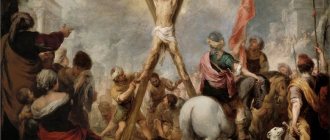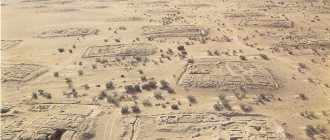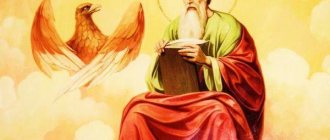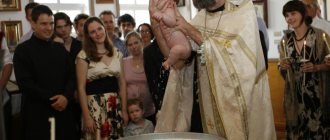Canon to the Holy Apostle Adronicus of Pannonia and others like him
Song a҃.
Irmos:
Let's look at the city that led its people through the Red Sea, and it became famous.
Praise brings, in your most holy, blessed memory, honorable church, your exploits in the glory of your faith.
He directed all your movements, sacredly, to your best wishes, and to fulfillment of joy and happiness.
Weeks of cleansing, dꙋ́hi ѿgonѧ́ti lꙋkavyѧ, ѿ bg҃a bzhⷭ҇tvennnꙋyu grace prїѧ́l є҆сѝ, bg҃omꙋ́ndre аndronі́che.
Bgorodichen:
Let me, two, receive salvation from all my sins, and correct my life, through your intercession and grace.
Song of the city.
Irmos:
There is no light in the world, and there is no righteousness in our God, and so all creatures sing: there is nothing more righteous than you, in ⷭ҇i.
By killing your progress, life has become a blessing for the living, on earth the flesh of the bearer of ours, andronia. ҆пⷭ҇le.
I was inspired by you, bzhⷭ҇tvennagѡ dkha, by the pure thought of your warmth, а҆пⷭ҇le, ѡ҆bnosѧ̀, and fell into the delights of thorns, and ndroniche valne.
Verb your things, and the power of where the world ends, where we learn, the blessings of the world are upon us yushchi.
Bgorodichen:
There is nothing more pure than you, my dear, and none is blameless except you, all blameless, for the spacious container of all was one.
Kontakion, voice v҃.
Let us praise the most holy star, blessed with the light of the enlightened language, and let us praise the holy god and with him for the good There is a great need for all of us, crying out: pray to God without ceasing for all of us.
Sedalen, voice d.
The Bzhⷭ҇tvennaya Andronik was luminous, the hearts were enlightened with great light when they came: also, at the end, the healing flows She, who faithfully adheres to this temple, and asks for great mercy to the faithful.
Bgorodichen:
I renewed it, chⷭ҇taѧ, bzⷭ҇tvennoy rzhⷭ҇yours, the dead creature that was destroyed in the passions of earth-born creatures, and I rebuilt it all ̑ ѿ from death to life ꙋ̀ imperishable. Moreover, for a long time, we are all blessed, the two most glorified, as she prophesied.
Krⷭ҇tobgorodichen:
On the brink of exalted ꙗ҆́кѡ ᲂу҆зрѣ̀ the prechⷭ҇taѧ mt҃i ѧ̀, in the word of bzhїy, monstrously sobbing things, what is new and strange with What the hell, my dear; how is the life of everyone in the face of death, how can the dead live, but mercy;
Song of the day.
Irmos:
From the blessed mountains, in the word, in the future, in the words of God, and with fear, praise the greater powers ꙋ yours.
I wholeheartedly praise your relatives, in front of the faithful, I praise your praises, preach, and andronic words, I praise the light guide. for those who live.
The house of the Trⷪ҇tsy of prestity, the temples and the sanctuary destroyed the blessed ones: and created the same, praiseworthy, church for the salvation of ours shikh.
It was possible with the full power of all, the strong to delight the neighbors, blessed, and to accomplish the task of living, and andronically.
Bgorodichen:
We always chant, two-by-one, in full agreement, for our firm and voluntary representation, and for the salvation of ours.
Song є҃.
Irmos:
And the nights of the unknown, let us enlighten the ends, enlighten us with the help of your loved one, where.
I am a relative of the same, and first of all a former student, we honor him, we came together in faith, andronically.
We will honor the luminous stars, the sacred ones, and the sacred and andronic ones.
In fact, the blessed pavel preaches to you in the church, blessed one.
Bgorodichen:
That, prestgаѧ ѻ҆trokovice, prⷪkročeskí face is outlined, sacred images, to be where the parents are.
Song of ѕ҃.
Irmos:
Give me a robe of light, with light, with a robe, our most merciful Christ.
Your house is filled with healthy sources, flowing with love, and it also washes your home.
The many languages that have been destroyed by godlessness have been updated with your new ones, imperishable ones and others, even sincere.
The sun is above the earth, and above all, the trisolar and uncreated one, proclaiming to the faithful the light of divinity.
Bgorodichen:
Bzhⷭ҇твєнaѧ сє́́їїѧ on you Ρκικικικκκαικικικαικικικακικικιακικικικακικιακικικιακικικιαικικικς
Song z҃.
Irmos:
In the beginning, the earth is new, and in a word, firm, blessed forever, where we are born.
The illnesses are dear, and all the illnesses and diseases of the world and the bodies of yogonisha flowing into your house, my dear ᲂу҆ч҃нѐ хр ⷭ҇tóv.
Demenskaya naitїї ѿgonѧ́eshi, and the passions of the fierce ones purify people, with the compassion of the people themselves: now for the sake of the world We are pleased.
Rhetorical, sir, more profoundly deposed by the simplicity of the teaching, which you preach in the flesh, having lived with earthly blessings for the sake of.
Bgorodichen:
In the morning of the two is the universe, and in it is born, blessed is he, where he is born of ours.
Song and.
Irmos:
On the mountain of fame, and in the world of everlasting glory, we will celebrate our secrets, where you sing and extol in everything. ́ki.
By the way, with the rot of the human, andronic, hearts, the salt of the life of the world, of yours, and of yours. in your words, we are being saved, presented to you, the noble woman.
The priest and the priest, and the victim, who sacrificed for mercy knew him, and to him he raised his eyes, and the andronic one, the crown of imperishability and truth and nothing.
A preacher of God, and a witness of God, a destroyer of the ruinous, and a richer of the poor. Uzbekistan is a great resident, androniche bg҃omꙋ́dre.
Bgorodichen:
with pincers of the rivers, with the pincers of the rivers, growing with the bzhⷭ҇tvennoyu exuding, two, the flame of flattery of the misfortunes, falling passion, no bearable togѡ̀ tsrⷭ҇tvїe.
Song ѳ҃.
Irmos:
What was revealed on the mountain by the law-giver in the beginning of the century, ours everlasting, in our faithful salvation, we magnify with silent songs.
Yes, the heir of our new lives, who were killed before by the demons, lived them all with your life-giving word, Zhenne Androniche.
Blessed is the vine, blessed is the vine, the immortality of the vine has fallen, and has made men’s hearts glad. Yes, most praiseworthy andndronic.
You, like lightning, fell into the thing of polytheism, you showed it to the world of God, with the one in this life: you Let us glorify everything, andronic.
Your sacred memory extends to the ends of the day, enlightens the hearts, in it there are those sacred praises, worthy of Andronia.
Bgorodichen:
Enlightenment of us and our questions, the light that was born, and the sin that was created, and our salvation, and the truth ꙋyu btsⷣꙋ, chⷭ҇taѧ two all-blameless.
Apostle Andronikos of the 70, bishop, Saint Iunia (Junia)
Life and works of the apostles – Holy Apostle Andronikos
Lives of the Apostle Andronicus from the age of 70 and his wife Junia
The holy Apostle Andronicus from the age of 70 and his assistant in apostolic labors, Saint Junia, were relatives of the Apostle Paul. They worked hard preaching the Gospel to the pagans, as the Apostle Paul mentions in his Epistle to the Romans: “Greet Andronicus and Junia, my relatives and prisoners with me, who were famous among the apostles and who believed in Christ before me” (Rom. 16:7). Saint Andronicus was ordained bishop of Pannonia, but his preaching and that of Saint Junia spread to other countries, far beyond the borders of his diocese. Through the works of Saints Andronicus and Junia, the Church of Christ was established, the pagans turned to the knowledge of God, many pagan temples ceased to exist, and Christian churches arose in their place. From the service in honor of these saints it is known that they suffered as martyrs for the Name of Christ.
In the 5th century, under the emperors Arcadius and Honorius, their holy relics were found on the outskirts of Constantinople along with the relics of other martyrs “like the Eugenievs” (February 22).
The pious cleric Nicholas Kalligrad had a revelation that among these 17 martyrs there were also the relics of the holy Apostle Andronicus. Subsequently, a majestic temple was built on this site.
Lives of the Apostles from the 70th Silas, Silouan, Criskentus, Epenetus and Andronicus
The Apostle of the 70, Saint Silas, was a respected man in the original Jerusalem Church, “a ruler among the brethren” (Acts 15:22). After the Council of the Apostles held in Jerusalem in 51 on the issue of the need to observe the Mosaic Law by pagan Christians, the apostles sent a message to the Antiochian Christians through the apostles Paul and Barnabas, in which they reported that by the decision of the Council, pagan Christians were exempted from observing the requirements of the Mosaic Law. It was decreed for them to abstain from eating things sacrificed to idols, from fornication, from strangulation and blood, and not to do to others what they do not want for themselves (Acts 15:20-29). Together with the apostles Paul and Barnabas, the Council sent members of the Jerusalem Church, Saints Silas and Judas, to Antioch to explain the message verbally, which they both accomplished with the assistance of the grace of the Holy Spirit. Then Saint Jude was released to Jerusalem, and Saint Silas remained in Antioch and zealously helped the Apostle of Languages in his missionary travels with the Gospel preaching. The apostles visited Syria, Cilicia, and Macedonia.
In the city of Philippi they were accused of disturbing the people, for which the holy apostles were seized, beaten with sticks, and then thrown into prison. At midnight, when the holy apostles Paul and Silas were praying, a strong earthquake suddenly occurred, the shackles fell from them and the doors of the prison opened. The prison guard, frightened that the prisoners had escaped, wanted to commit suicide, but was restrained by the Apostle Paul. Then, falling with trepidation at the feet of the apostles, he with faith accepted the gospel of Christ from them, led them out of prison, brought them to his home, washed their wounds and was baptized with all his household.
From Philippi, the apostles Paul and Silas went to the cities of Amphipolis, Apollonia and Thessaloniki, acquiring new disciples of Christ in each city and establishing the Church.
In Corinth, the holy Apostle Silas was ordained bishop; there, having performed many signs and wonders, he ended his life.
The Holy Apostle Silouan preached the Word of God together with the Supreme Apostles Peter and Paul. In the 1st Catholic Epistle, the holy Apostle Peter mentions him: “I wrote these things briefly to you through Silvanus, who, as I think, is your faithful brother” (1 Pet. 5:12). Saint Silouan was installed as a bishop in Thessaloniki and died there as a martyr, having endured many sorrows and misfortunes for the sake of the Lord.
The holy Apostle Paul mentions the holy Apostle Criscent in his 2nd Epistle to Timothy (2 Tim. 4:10), saying that Criscent went preaching to Galatia. There he was installed as a bishop, and then preached the Word of God in Gaul. In the city of Vienna, the Apostle Crescent installed his disciple Zacharias as bishop. Returning to Galatia, he died a martyr under King Trajan (98–117).
The holy Apostle Epenetus was installed as bishop in Carthage. In the Epistle to the Romans (Rom. 16:5), the holy Apostle Paul writes: “Greet my beloved Epenetus, who is the firstfruits of Achaia for Christ.” In the same Epistle, the Apostle Paul also remembers the Apostle Andronicus: “Greet Andronicus and Junia, my relatives and prisoners with me, who were glorified among the apostles and who believed in Christ before me” (Rom. 16:7). The holy Apostle Andronicus was a bishop in Panonia (memory of Saints Andronicus and Junia on May 17).
See also: “ Memory of the Holy Apostle Andronicus and Junia, his assistant ” as presented by St. Demetrius of Rostov.
See also: “ The Holy Apostles Silas, Silouan, Crescent and others with them” as presented by St. Demetrius of Rostov.
Convinced monarchist
Bishop Andronik.
Image from the site newmartyros.ru With the beginning of the First World War, Bishop Andronik organized many infirmaries for the wounded in his diocese, visited them himself, and consoled them.
In the summer of 1916, the saint visited the front at Tsar's Headquarters. There he met with Tsar Nicholas II. The Bishop tried to warn the Tsar against his “countryman” Grigory Rasputin, but the Tsar, having listened politely, asked the Bishop “not to believe all nonsense.”
After this meeting, the bishop often said in sermons that the internal enemy is much more dangerous than the external one, and the transition from a monarchy to another form of government without the destruction of Russian statehood is impossible. In 1916, he created special missionary courses to expose the new socialist-communist false teaching: “The duty of conscience of a loyal subject and boundless love for the Fatherland do not allow me to remain silent.”
Unlike many bishops and priests who were indifferent to the political situation in the country, the bishop considered such indifference to be incorrect; he saw the reason for it not at all “in dispassion,” but in laziness, fear and unwillingness to delve into the essence of the events taking place.
In the opinion of Bishop Andronik, someone other than a shepherd must see and know everything that is happening in the country, understand the spiritual meaning and be able to clearly explain it to the people with the truth of Christ.
Having learned at the beginning of March 1917 about the abdication of the Tsar from the throne, the ruler told the people: “The dishonest Tsar’s advisers and servants in their calculations hid the truth from the Tsar’s heart and did everything to separate the Tsar from the people and achieved their goal, but having achieved it, they were the first and left the Tsar alone, refusing to serve him further.”
Andronikov Monastery
In 1354, Metropolitan Alexy of Kiev and All Rus' was caught in a storm on his way to Constantinople. He made a vow to build a cathedral in Moscow in honor of the saint or holiday on the day of which he would safely reach the Golden Horn Bay. The day fell on the celebration of the Savior Not Made by Hands. Monk Andronik became the abbot of the new monastery. For a long time, the monastery preserved a well, which was considered holy and, according to legend, dug by him. On the territory of the Andronikov Monastery there was one of the oldest skudelnitsa (mass burial) in Moscow.
The original wooden cathedral of the Andronikov Monastery was built from plinth stone Spassky Cathedral, from which white stone reliefs with fragments of zoomorphic and plant compositions, archaic in style and execution, have been preserved. In 1420-1427, the Spassky Cathedral was rebuilt again, and the white stone church of that time has survived to this day. In the interior of the Spassky Cathedral, fragments of frescoes painted around 1428 by Andrei Rublev, who was a monk of the Andronikov Monastery, have survived. In the XIV-XVII centuries, the Andronikov Monastery was one of the centers for the correspondence of books; The monastery's manuscript collection included a significant part of the works of Maxim the Greek. In the Middle Ages, the monastery was repeatedly destroyed (1571, 1611). In August 1653, the hieromartyr and confessor Archpriest Avvakum was kept in custody in the monastery.
At the request of Tsarina Evdokia Lopukhina, in 1691 a temple was built over the refectory of the monastery, in the third tier of which the Church of St. Alexei the Metropolitan was established. In the middle tier there was built the Church of the Archangel Michael with the chapel of the Holy Apostles Peter and Paul, which was abolished in 1819. In 1690, a corps of abbots was erected near the Holy Gate of the monastery; later the fraternal buildings were rebuilt. In 1747-1756 the walls of the monastery were rebuilt in stone. According to the design of the architect Rodion Kazakov, a new one 73 m high was erected on the site of the old bell tower, above the Holy Gate. During the fire of 1748, the library and archive of the monastery were badly damaged. In the 18th century, the murals of the Spassky Cathedral were almost completely cleaned off; Since then the cathedral has not been painted. During the restoration of 1763-1779, a covered porch was added to the cathedral. In 1812, the monastery was destroyed by the French. The fire destroyed the monastery's archives. The iconostasis burned down and the drum and the head of the Spassky Cathedral collapsed. In 1846-1850, the cathedral was significantly remodeled according to the design of Peter Gerasimov: a chapel of the Assumption of the Mother of God was added to the cathedral from the south, and St. Andronicus from the north. In the 19th century, a theological school and library operated at the Andronikov Monastery. By 1917, there were 17 monks and one novice in the monastery.
The monastery was closed by Soviet authorities in 1918. On its territory, along with the Ivanovsky and Novospassky monasteries, one of the first concentration camps of the Cheka for officers and political opponents of the new government was located until 1922; mass executions were carried out in the camp. In 1922-1928, the monastery housed a colony for street children. In 1928, the territory was transferred to the jurisdiction of the workers' collective; 200 rooms for workers were built in the monastery buildings, including churches. In the 1930-1940s, institutions of the People's Commissariat of Defense were also located there. In 1929-1932, the bell tower of the monastery was destroyed, and on September 13, 1927, the necropolis of the Andronikov Monastery was destroyed.
Enormous merit in preserving the dilapidated monument and turning it into a museum belongs to Pyotr Baranovsky and G.F. Senatov; the works of Pyotr Maksimov and Boris Ognev played a large role in identifying the original forms of the cathedral.
The revival of the monastery began after the Great Patriotic War. In 1947, an initiative group led by academician Igor Grabar turned to the government with a request to create a Museum of Old Russian Painting on the territory of the monastery. On December 10, 1947, Chairman of the Council of Ministers of the USSR Joseph Stalin signed Resolution No. 3974 on the creation of a historical and architectural reserve named after Andrei Rublev in the Andronikov Monastery. But during the Khrushchev Thaw, work on creating a museum-reserve was frozen, which forced authoritative experts on ancient Russian culture Mikhail Alpatov, Nikolai Voronin, Varvara Adrianova-Peretz, Dmitry Likhachev to issue an open letter in the newspaper Pravda (No. 300, 26.10. 1956). In 1959-1960, restoration of the original forms of the Spassky Cathedral was carried out, including the controversial restoration of the shape of the lost dome and kokoshniks.
After a repeated letter from academicians Alpatov and Sergei Gerasimov, Nikita Khrushchev was forced to allow the official opening of the Andrei Rublev Museum in 1960, which was declared by UNESCO "the year of the Russian icon painter Andrei Rublev" in connection with the 600th anniversary of his birth. Since 1985, the museum has been called the Central Museum of Ancient Russian Culture and Art named after Andrei Rublev (CMiAR). In 1989, the Spassky Cathedral was consecrated, and services were resumed.
In January 2022, the Russian Orthodox Church turned to the Federal Property Management Agency with a request to transfer to the Russian Orthodox Church for use in accordance with its charter the objects at Andronevskaya Square, 10 and 11: preserved parts of the walls and towers, the building of the former theological school, the abbot's chambers, the Spassky Cathedral, the fraternal building, the refectory chamber, the Church of the Archangel Michael and the tomb of the Lopukhin boyars.
A little history
In the first centuries of Christianity, people's faith was stronger. She was tested by difficulties and the threat of death for Christ. When the difficult time of persecution of Christians began, many people in and around Constantinople were captured and brought before the ruler for their faith. Many of them were subjected to cruel torture and execution for their faith. But this could not frighten the true believers.
They were not afraid to confess their faith, and they considered death for Christ a great good. The bodies of martyrs for the faith were buried near Constantinople. Something like a mass grave existed near the city gate, called “Evgeniev”. Hence the area began to be called “Evgenia”.
No one knew the names of these people who died for their faith. The bodies of unknown martyrs were thrown into a pit and buried. They began to be called “martyrs like Eugene . Later a church was built into which the relics of the martyrs were transferred.
It was revealed to one Christian, named Nicholas Calligrapher, from God that among these martyrs located in Eugene were the bodies of the Apostle Andronicus of the Seventy and his faithful companion Iunia. Then Emperor Andronicus built a magnificent temple in honor of his Heavenly patron. This happened in the twelfth century.
Single alarm
Permian.
1920s Image from the site archive.perm.ru After declaring his non-conciliatory position towards the new government, the saint understood that he would soon be arrested. They had already tried to arrest the saint, but the people defended him. The authorities were frightened and responded to the deputations asking for the bishop (among which there was a Muslim one) that they had no questions for the bishop.
And then she resorted to a trick: she declared martial law in Perm: without passes it was impossible to leave before or after a certain hour. More than one and a half thousand Red Army soldiers came to arrest the ruler.
Armed policemen were stationed near the bell tower so that believers could not ring the alarm. And after midnight they came and took the bishop. There was a daredevil who did not spare his life to try to save the ruler: he sounded the alarm and was immediately shot.
And yet the alarm bell was heard. Crowds of people came to the police building, despite the martial law, demanding the release of the saint. The Bolsheviks had to use force to suppress popular outrage.
Veneration of St. Andronik of Moscow
The canonization of Andronicus of Moscow took place at the end of the 15th century, although the Monk Joseph of Volotsky already in his “ Answeration to the curious and a brief tale of the holy fathers who were in the monasteries of the Russian land ” (1507) cites Andronicus as one of the most revered Russian saints. The Monk Andronik was buried in the Spassky Cathedral of the Andronikov Monastery. In 1812, the French plundered the monastery, but the relics remained intact; the head, however, disappeared. After 1917, the relics also disappeared.
As a result of archaeological research in 1993, under the ancient throne of the Spassky Cathedral of the Andronikov Monastery, the most ancient burials were discovered, attributed by the scientific director of the excavations, Professor Oleg Ulyanov, to the founders of the Spaso-Andronikov Monastery - Andronik of Moscow and Savva of Moscow.
"Holy Spouses" Venerable Andronicus and his wife Athanasius. Orthodox calendar for October 22
October 22 (October 9 according to the “old style” - the church Julian calendar). Friday of the 18th week of Pentecost (the eighteenth week after the Feast of the Holy Trinity, otherwise known as Pentecost). Fast day, according to the Church Charter, food with vegetable oil is blessed at the meal. Today in the Russian Orthodox Church the memory of 13 well-known saints of God and one revered shrine is celebrated. Next we will briefly talk about them.
Venerable Andronicus and his wife Athanasius . Antiochian saints 5th century , a righteous Christian couple who divided all their income into three parts. The pious spouses gave one to the Church, donated the second to those in need, and kept only the last for themselves. After the death of their children, Saints Andronicus and Athanasius did not break down, but decided to devote their lives to God.
For about 12 years, Andronik and Athanasia performed monastic deeds in different monasteries, and after this time they met, but did not recognize each other - their spiritual ascetic labors changed so much. Afanasy’s mother at that time took on a male appearance, and as a result, the former spouses ended up in the same cell, never knowing who was who. And only after the blessed death of the Monk Athanasia, Saint Andronicus learned her secret and also soon departed to the Lord.
It is noteworthy that in the 20th century, during the Soviet anti-church persecution in 1929, Alexei Fedorovich Losev and his wife Valentina Mikhailovna took secret monastic tonsure in honor of the Venerables Andronik and Athanasius You can read more about this amazing thinker of the last century in our material “The Arbat Elder”, published on the pages of Constantinople.
* * *
Apostle Jacob Alfeev . One of the twelve first disciples of Christ, brother of the Apostle-Evangelist Matthew. After Pentecost (the descent of the Holy Spirit on the Apostles), Saint James preached the Word of God together with the Apostle Andrew the First-Called, traveling throughout Judea, as well as cities such as Edessa, Gaza and Eleutheropolis. The Apostle James converted many Jews and pagans to Christ, but in one of the Egyptian cities he was destined to suffer a martyr's death - to be crucified on the cross, like the Savior.
Righteous Abraham and his nephew Lot . Some of the greatest Old Testament saints who lived at the end of the 3rd millennium BC . Every Christian should know the history of these forefathers, the righteous of the Old Testament, and for this we strongly recommend reading (or re-reading) the first of the Pentateuch of Moses - the Book of Genesis.
Righteous Abraham. Photo: pravoslavie.ru
Martyrs Iuventin (Evventiy) and Maxim, warriors . Saints of the 4th century who accepted the crown of martyrdom for loyalty to Christ and His Church during the reign of the pagan emperor Julian the Apostate, who reigned in the Roman Empire in 361–363 AD . Let us recall that Emperor Julian tried to destroy the legacy of the holy Equal-to-the-Apostles Emperor Constantine the Great , who made the Roman Empire Christian. But it was precisely such saints as the warrior-bodyguards of the wicked emperor Juventinus and Maximus, who refused to obey pagan orders (to sprinkle food in the market and wells with the blood of idols) and accepted martyrdom for this, who revived the Christian empire with their exploits.
Martyr Poplia of Antioch, confessor . This saint, who also suffered during the time of the wicked emperor Julian the Apostate for her profession of the Christian faith, was a deaconess. Let us remind you that this ancient church rank does not correspond to the diaconate, to which only men are ordained. And at the same time, deaconesses helped the clergy in churches, and were also responsible for parish social service and charity.
Martyr Poplia (Publia) of Antioch. Photo: pravoslavie.ru
Venerable Peter of Galatia, Constantinople . Saint of the Universal Church, who performed his spiritual monastic deeds in the 9th century after the Nativity of Christ.
Hieromartyrs Konstantin Sukhov and Peter Vyatkin, presbyters (1918), Konstantin Aksyonov, presbyter (1937), finding the relics of St. Sebastian (Fomin), Karaganda confessor (1997) . Orthodox sufferers in the priesthood and monastic order, who accepted the crown of martyrdom on this day in different years of the era of Soviet atheistic persecution and were glorified as saints in the many thousands of new martyrs and confessors of the Russian Church. more about one of them, the Venerable Sebastian , from our material “Successor of the Optina Elders,” published on the pages of Constantinople.
Korsun Icon of the Mother of God . Miraculous image of the Blessed Virgin Mary, copy from an icon painted by the Apostle-Evangelist Luke in the 1st century . This icon was delivered to Kiev by the Baptist of Russia himself, the Holy Equal-to-the-Apostles Grand Duke Vladimir, 988 AD
* * *
Congratulations to Orthodox Christians on the day of this shrine and to all today's saints! Through their prayers, Lord, save and have mercy on us all! We are happy to congratulate those who received names in their honor through the Sacrament of Holy Baptism or monastic tonsure! As they used to say in Rus' in the old days: “For the Guardian Angels - a golden crown, and for you - good health!”





